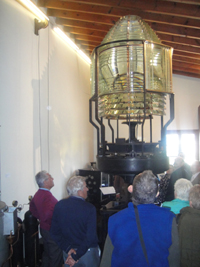
The maritime signalling exhibition at the Portopí lighthouse received nearly 1,700 visitors in 2013
Palma de Mallorca
20/03/2014
The Port Authority of the Balearic Islands (APB) registered nearly 1,700 visitors to its permanent maritime signalling exhibition at the Portopí lighthouse in 2013. This exhibition brings together one of the most comprehensive and best-known collections of used maritime signalling equipment, both in Spain and abroad, dating from the mid-nineteenth 19th century onwards.
This APB exhibition is visited annually by numerous social and professional associations, academic organisations, schools, and the general public who may view, by prior appointment, highly-valuable maritime signalling equipment used on the Balearic Islands in the past. This equipment has been recovered and preserved for future generations.
Appointments to visit the exhibition can be made for Monday, Wednesday and Friday mornings by calling (00 34) 971 228 487, or by emailing fardeportopi@portsdebalears.com. The exhibition can also be visited online at
See page
Tenth anniversary
May 2014 marks the tenth anniversary of this cultural space, housed within the Portopí lighthouse (Port of Palma), which is the third-oldest working lighthouse in the world. In the 1980s, in the light of the significant changes taking place in maritime signalling on the Balearic Islands, and the even more revolutionary advances yet to come in the short-term, the then director of the Port of Palma, Rafael Soler Gayá, decided to recover and preserve all the equipment that had been withdrawn from the coastal lighting service.
When some of the equipment had been restored by maritime signalling mechanics, the APB decided to place it on display in some of the empty rooms at the Portopí lighthouse.
In 1998, following the retirement of the Portopí lighthouse keeper, Pere Bonet, his former living quarters became a part of what would eventually become the exhibition. In 2004, it was decided that the permanent exhibition would be more formal, in concept, as it was given a more informative focus. The exhibition continues to see newly restored material being added on a constant basis.






